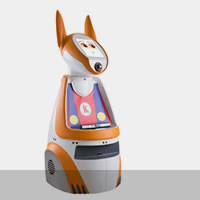Vision Robot(II)
Hybrid Eye-to-hand and Eye-in-hand Visual Servo System for Parallel Robot Conveyor Object Tracking and Fetching
This system aims at integrating robot arm and image processing algorithm for further application. The vision servo algorithm is proposed to recognize the workpiece on the conveyor. Meanwhile, the vision servo would apply both recognition and tracking method to estimate the position and orientation of the workpiece every frame. Taking the advantage of the proposed vision method, the robot arm could pick the workpiece on the belt after tracking in arbitrary ideal picking position. All workpieces in the belt are allowed to be arbitrary placed, and, the vision servo should detect the picking point and estimate the pose very accurately. As the result, workpieces would be arranged by specific order and pose by parallel robot. The descriptive condition above is special designed for industrial application. Hence the system are of much academic interest and applied value.

Pomblem Statement and Motivation
For the pick and place case, the monocular eye-to-hand seems to be the only choice for parallel robot. This method functions good for stationary objects, even in the application with 3D-printer based on parallel robot Configuration. Monocular eye-to-hand camera is often mounted on the fore-end of the robot holder so that the parallel robot arm would not appear in the FOV of the camera. A relatively wide FOV of this camera is not enough for the case of moving objects. Once multiple objects appear in the FOV of eye-to-hand camera, the decision should be given at once, or the objects will be out of the FOV. Sometimes the fast parallel robot arm couldn’t handle all pieces in the view which means some objects should be fetched without visual servo. Certainly, if these workpieces moves uniform linearly, the velocity estimation will help the arm to fetch them out of the view. However, the fetching accuracy will decrease sharply with unstable moving velocity of the object or the accumulative error of the estimation algorithm.